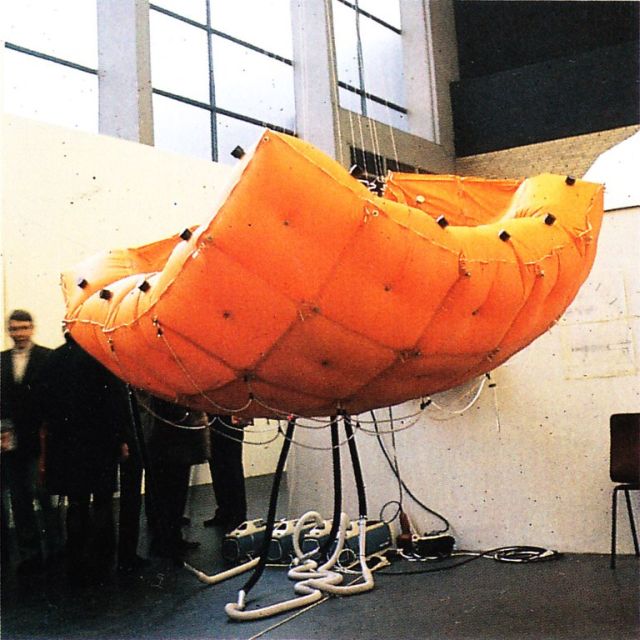
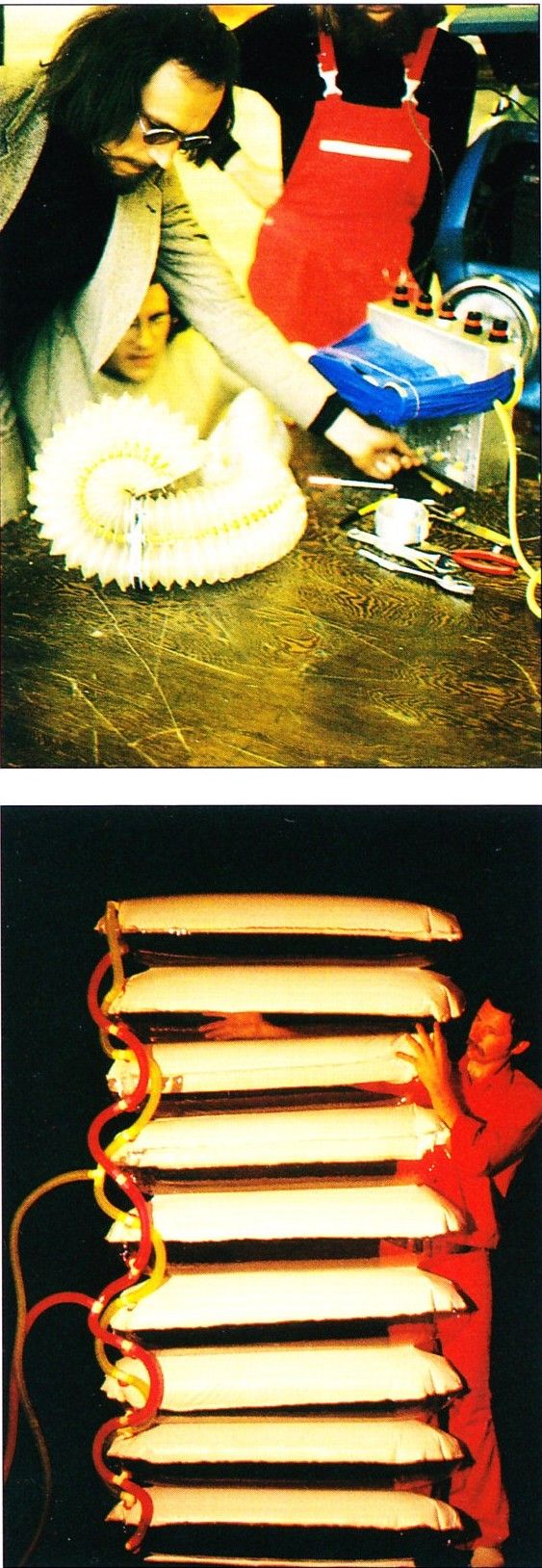
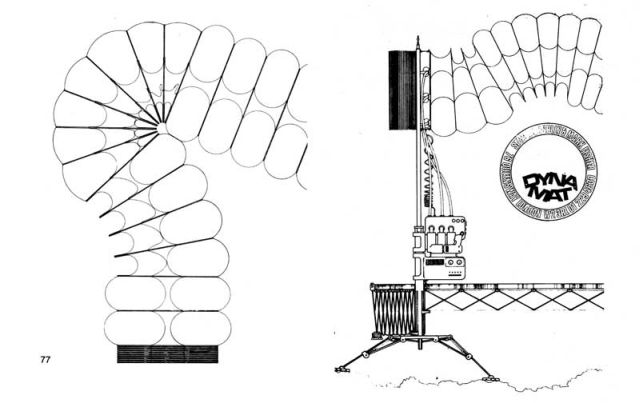
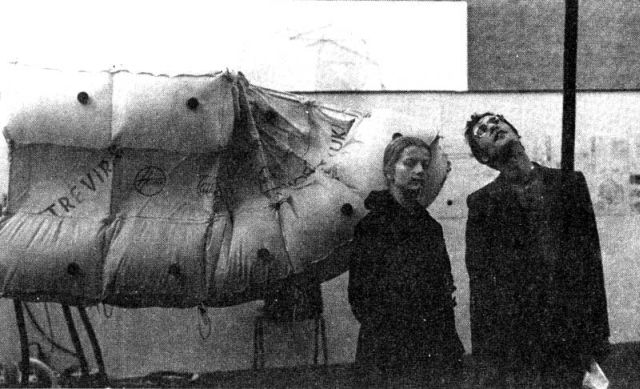
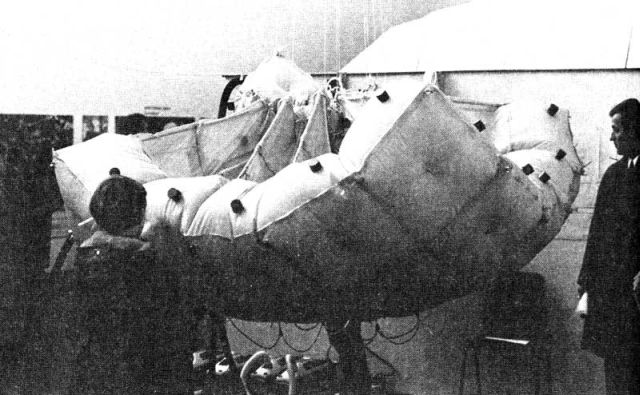
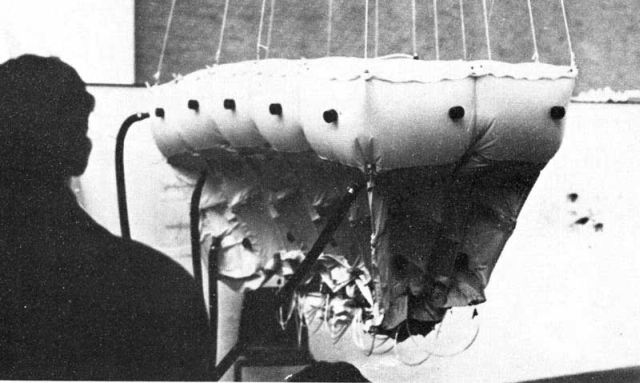
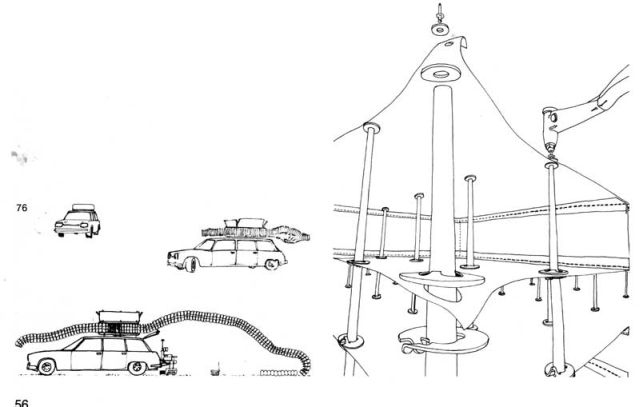

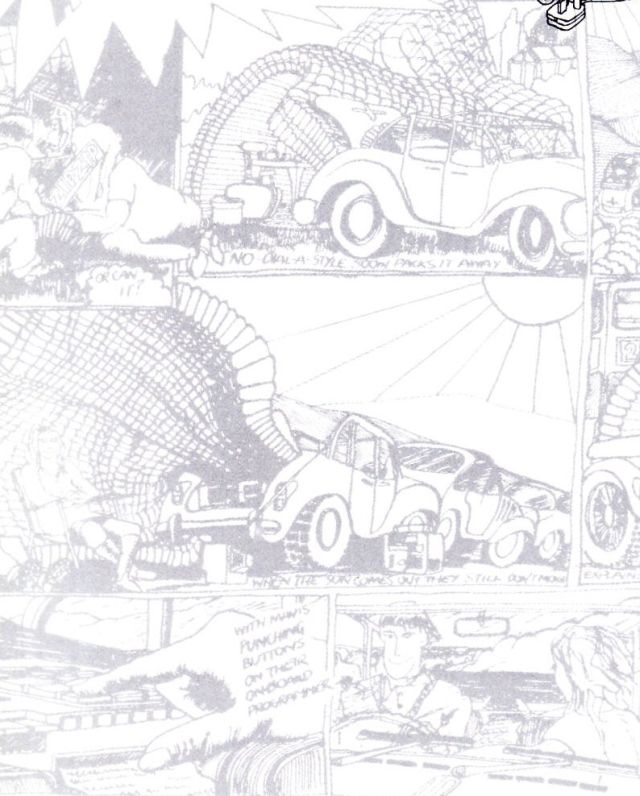
Source: Mark Fisher: staged architecture by Eric Holding – 2000
Dynamat
Whilst studying for his Diploma at the AA (1969-71) under Peter Cook, Fisher continued to investigate the potential of inflatable technology, and took a particular interest in the way it could create environments able to respond quickly to a user's changing physical requirements. This idea was explored in Dynamat, a project carried out with fellow student and co-editor of `Pneu World', Simon Conolly.
The Dynamat project was essentially an extension work on Automat, but resolved many of its fabrication problems and increased the range of its potential application. Fisher and Conolly constructed a full-sized prototype panel of Dynamat which was exhibited in 1971 at 'Deubau', the German International Building Exhibition in Essen. The structure consisted of a series of inflatable cells combined in groups, which could be selectively expanded or contracted to produce changes in form. Whereas these movements had been controlled by pneumatic jacks on Automat, a simpler system was designed for Dynamat in which air routes between adjacent cells were controlled by a series of valves which opened and closed in pre-programmed sequences.
In its deflated state, Dynamat could be stored in the boot of a car for easy transportation, and individual panels could be combined to create a continuous surface which was shaped to enclose space, and to provide shelter for people or objects. An advanced control system was developed for the project which allowed for the sequential programming of the structure. Different configurations were stored on prerecorded cassettes and presented the user with a range of possible spatial environments, or more complex sequences of enclosure which responded to, for instance, environmental changes in the diurnal cycle. As the programming of Dynamat increased in sophistication, it became obvious that the real usefulness of these structures lay in applications where performance criteria were more demanding than for traditional forms of architecture, where purpose-built temporary mobile structures would be more appropriate than more fixed and permanent solutions.
In addition to its appearance at 'Deubau', Dynama: was featured in an article entitled `Pneu Moves' published in 1972 in Architectural Design. Fisher also presented a paper on the research at the Delft 'Pneumatic Structures Symposium' in September of the same year. However, whilst the technical aspects of the project received widespread interest, Fisher and Conolly were also fascinated by the social implications of such new technologies. Fisher explored this through a series of drawings which showed how the Dynamat structure could be deployed within the lives of 'ordinary' people. These cartoon images related 'The Adventures of 'Amersham 'Arry', a stereotypical, suburban London character, who was depicted in various scenarios with his inflatable Dynamat which could be reconfigured via his 'ever attentive "dial-astyle" modem'. In this respect, Fisher's work began to reflect more of the low-key approach to technology assumed by David Greene in his Bottery project of 1969, which was more engaged with the idea of everyday life than the spectacular environments proposed by Peter Cook and Ron Herron.
'Windbags', which appeared in New Society during April 1968, that in architectural circles, 'What is new is the confluence between changing taste and advances in plastic technology. The taste that has been turned off by the rectangular format of the official modern architecture … is turned right on by the apparent do-it-yourself potential of low pressure inflatable technology.'
Banham's comments were used as a preface to an issue of Architectural Design magazine entitled `Pneu World' which was published later in the same year. This became an influential document in the late 1960s, as it was the first major survey of pneumatic structures, and was guest edited by Fisher's collaborator on Automat, David Harrison, together with fellow AA students Johnny Devas, Mike Davies, David Martin and Simon Conolly. The individual projects, which were drawn from a wide range of sources, were considered not only in terms of their different constructional typologies, but also for the way in which they were capable of redefining the traditional relationship between people and their environment. Coincidentally, the same magazine carried a small news item announcing the death of modernist architectural historian Siegfried Gideon, who had been a powerful advocate of the kinds of architecture these new technologies sought to replace.
Although Banham's comments on inflatable structures indicate some of the reasons why pneumatic structures became so popular within a relatively short space of time, it was not only their new shapes and forms that appealed to designers: a number of other inherent characteristics reinforced their appropriateness. Firstly, there was the matter of their environmental responsiveness and ephemerality, which stood in stark contrast to the increasingly monumental and static forms of modernity. Secondly, the cheapness and simplicity of these structures meant that they could be created or owned by anyone, a 'democratic' approach to spatial enclosure that was very much attuned to the times, and thirdly, their disposability connected with a pre-environmentally aware consumer consciousness, that still believed in the notion of unlimited natural resources. Finally, there was the fact that 'ordinary' people could interact with these structures; the culture of inflatability had a vitality and sense of fun that was missing in the formal properties of much modern architecture. As Peter Cook observed in Experimental Architecture, in comparison to other architectural forms, 'Pneumatics have been far more popular with the general public: a condition which is rare in anything experimental.'
Inflatables and Structures
Fisher had seen his first anthropomorphic inflatable Mother of the Arts in 1966. It was an inflatable woman designed by fellow Architectural Association students for the annual Lord Mayor's procession. It was based on Jean Tinguely's She, a long, hollow reclining woman whose vagina was the entrance to the exhibition inside shown earlier that year at Stockholm's Moderna Museet. In the procession, the designers of Mother of the Arts wielded coloured marker pens on the inner surface of the clear polythene blow-up.
Four years later Fisher and Simon Conolly built a 14-metre- (46-ft-) long inflatable submarine which toured on the back of a flatbed truck and featured at several exhibitions. In 1969 they had set up the firm, Air Structures Design, as a commercial vehicle for making lightweight tents and inflatables; the profits from this financed their student work on an inflatable mat which could be configured in a number of ways as a rigid structure. An interim version, Automat. was exhibited at the 1969 Paris Biennale and the two submitted a final version as their final year thesis project. Dynamat was a muti-celled inflatable structure which could be bent and shaped by varying the air pressure in each cell.
Fisher's and Conolly's final year Architectural Association project, Dynamat, was a multi-celled structure which could be transported folded in, say, the boot of a car. and then inflated into whatever shape was needed at the time.
The success of Woodstock inspired many similar events such as the Isle of Wight Festival, for which Fisher helped build the stage structure designed by the engineer Anthony Hunt. Inevitably through his own direct experience of attending events like this, and given the powerful influence of Archigram, Fisher's work reflected the spirit of the times, which is apparent in his designs for an Adult Theme Park carried out in 1970. The drawings, which have a loose playful quality, depict a youthful population exercising its right to hedonistic behaviour, and inhabiting an artificial entertainment landscape, complete with hover-dodgems, disposable hot air balloons, bouncy floors, and escape towers.
It is interesting to observe the emphasis placed on technology in this scheme — and in the work of Archigram — which can be seen as a response to the advances that were taking place during the 1960s, such as the Apollo space programme, Sea-Lab, the introduction of the hovercraft and the Boeing 707. Whilst many of these technological developments were a direct result of cold war research programmes, they were all perceived to extend the capabilities of mankind, and as a result technology was seen as a form of social emancipation which was to be embraced. Rock music itself depended upon new technology, not just for the amplification of instruments and the emergence of the electric guitar, but also for the advent of television which played a significant role in its rapid rise in popularity.
Fisher's fascination with technology is manifest in his Automat project of 1968, which he carried out in collaboration with fellow student David Harrison. The liberal pedagogical stance assumed by the Architectural Association at this time meant that they were positively encouraged to develop their own approach to architectural design, and as a result the project emerged out of a sustained period of practical experimentation. Automat was an attempt to create a self-articulating form which altered shape in response to its users' changing physical requirements. In order to achieve this they created a rudimentary low-pressure pneumatic structure which was articulated using a system of internal bracing cables connected to high-pressure jacks which could selectively expand or contract the structure at a ratio of 80:1. Although some problems were encountered with fabrication, the structure was exhibited at the Paris Biennale in I969, and the project was featured in Peter Cook's publication Experimental Architecture in 1970.
Source: Pneumatic structures: a handbook of inflatable architecture by Thomas Herzog p74-78.
Dynamat
Design: Simon Conolly and Mark Fisher, 1971
The elements presented here also originate from the British Isles, as do so many innovations in the field of pneumatic structures. The Dynamat, whose prototype was exhibited at the DEUBAU 1971 in Essen, is one example of a whole series of similar attempts in which the user is given the opportunity of creating an environment for himself and of manipulating its form. The volume of the folded mat is over one hundred times smaller than the envelope when opened out.
The changes in shape are not achieved by mechanical means but by mere alteration of the air pressure in the individual cells, which are separated from each other by airtight divisions. These cells are connected to the central control by 3 mm tubing, and are held vertically by rigid alloy tubes.
By regulating the air input, individual or total movements of the structure are carried out centrally or decentrally.
The mat consists of individual square elements, which can be composed to form surfaces of any site by means of zip fasteners. The stage of development shown cannot, however, be viewed as final since the taking up of transverse forces, for example, has not yet been fully mastered structurally.
One Reply to “1971 – “Dynamat” – Mark Fisher & Simon Conolly (British)”
Comments are closed.